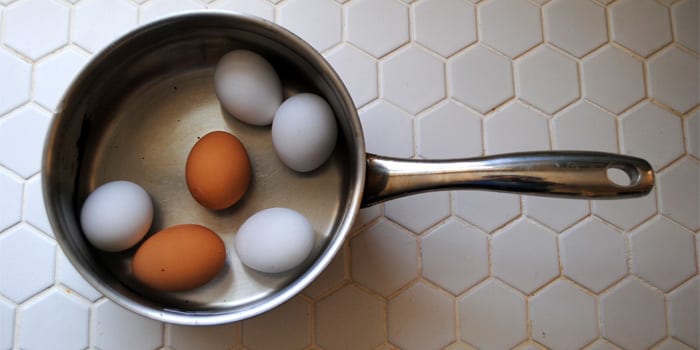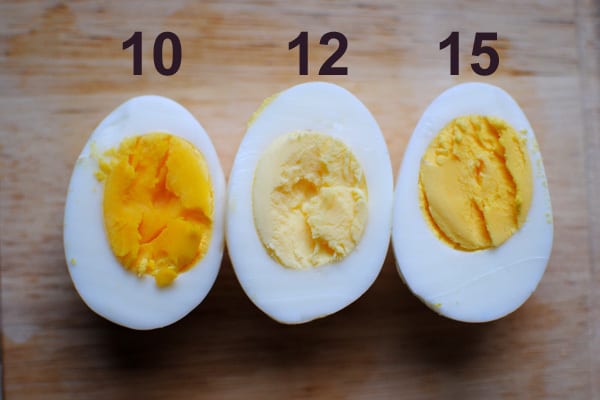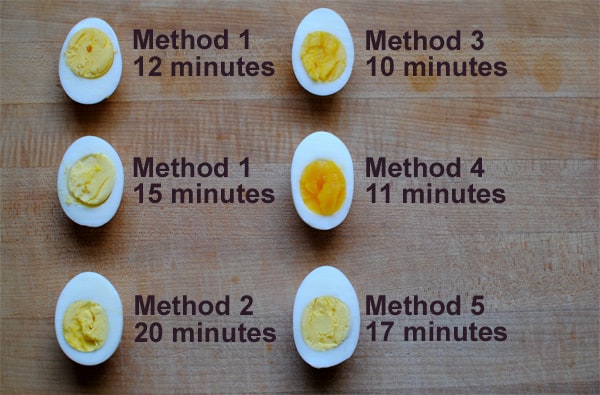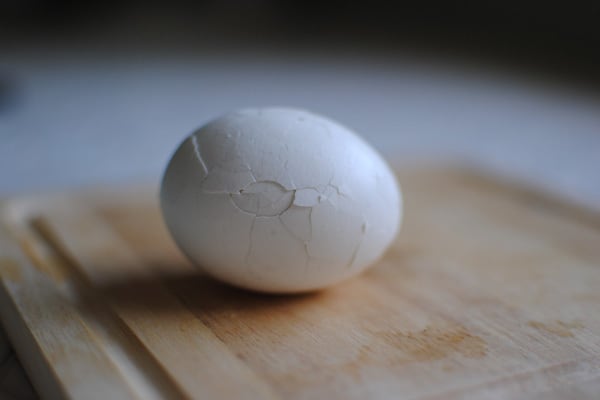How to Make Hard-Boiled Eggs

Eggs are pretty incredible. The whites are full of protein and the yolks are dense in nutrients like A, B, D, and E vitamins, omega-3s, and choline. Not bad for about 72 calories per large egg.
Plus, hard-boiled eggs make a great snack and are wonderful in salads. But, making them… well, that’s another story. Once you’re done peeling a hard-boiled egg, it can look like half the embryo it used to be.
To make matters worse, yolks are often gray-green and stink of sulfur. So, we set out to investigate just how to perfectly cook (and peel) a hard-boiled egg.
Boiling the Eggs
Everyone has their own method. After considering suggestions from Julia Child, The Kitchn, Serious Eats, Simply Recipes, and a host of foodie friends, there appear to be five methods worth testing.
After using a mix of large brown and white eggs purchased at the supermarket and boiled via a 2-quart saucepan on a gas stove, here are the results:
Method 1: Passive boiling

- Place eggs in saucepan. Fill pan with cold water until eggs are covered by one inch. (Measured, in this case, using a ruler. This is science, after all.)
- Heat water over high heat until it is at a full rolling boil.
- Remove pan from heat, cover with lid, and leave for 10-18 minutes.
- Next, carefully drain the hot water and place eggs directly into a bowl of ice water. (Not just cold, but ice-cold. In this case, a large metal mixing bowl was filled halfway with cold water, into which a large chunk of ice was added.) Do all of this as quickly as you can safely. The idea is to “shock” the eggs.
- Let the eggs sit in the ice water for at least 15 minutes before peeling.
Results: This was easy, practically foolproof, and produced delicious eggs at three different intervals:
10 minutes of cooking yielded soft, flavorful yolks.
12 minutes in the pot left the yolks a bit chalky, but still edible.
15 minutes or more of boiling made the eggs very chalky-tasting, but no gray-green color nor taste of sulfur.
Method 2: Flash cooling
- Place eggs in saucepan. Fill pan with cold water until eggs are covered by one inch.
- Heat water over medium heat until it is at a full rolling boil. Let eggs cook for 15 seconds, then remove pan from heat, cover with lid, and leave for 20 minutes.
- Next, carefully drain the hot water and replace it with cold water.
- Let the eggs sit for one minute in the cold water. Peel.
Results: The eggs had a bit of a sulfuric smell, but weren’t gray-green and the yolks tasted slightly less chalky than the 12-minute eggs in method 1.
Method 3: Rest, then boil
- Place eggs on the counter for 20 minutes, then add them to saucepan.
- Fill pan with cold water until eggs are covered by one inch.
- Heat water over medium heat until it is at a full rolling boil. Immediately remove pan from heat, cover with lid, and leave for 10 minutes.
- Then, carefully drain the hot water and place the eggs in ice water. Leave them for at least 15 minutes before peeling.
Results: The yolks were a little on the done side, but the flavor was good.
Method 4: Boil, then drop
- Fill pan with hot water and bring to a full rolling boil. Carefully submerge the eggs in the hot water.
- Let the eggs boil for 30 seconds, then drop the heat to a very low simmer and let the eggs cook for 11 minutes (don’t cover the pan).
- Next, carefully drain the hot water, and place the eggs in ice water. Leave them for at least 15 minutes before peeling.
Results: The egg didn’t look completely done, but was actually very rich in flavor. If opting for this method, you might want to let them sit for 12 or 13 minutes instead of 11.
Method 5: Boil/re-boil
This is the Julia Child method. It’s also the most complicated.
- Place eggs in saucepan. Fill pan with cold water until eggs are covered by one inch.
- Heat water over high heat until it is at a full rolling boil. Immediately remove pan from heat, cover with lid, and leave for 17 minutes.
- Next, carefully drain the hot water into another pan and place the eggs in ice water. Leave them in the water for 2 minutes.
- Meanwhile, return the hot water to the original pan and put it on the stove over high heat.
- After the 2 minutes have passed, put the eggs back in the pan. When the water comes back to a full rolling boil, let the eggs cook for 10 seconds.
- Remove the eggs from the pan, place them back in the ice water and leave them for 15 to 20 minutes before peeling.
Results: This egg yolk was as dry as burnt toast. Not enjoyable at all.
For those curious about how the egg whites fared, they came out perfectly with all of the different methods. Those cooked in cold water (all but method 4), however, had a more evenly cooked egg white, where the egg white in method 4 felt a little soft.
Final results

So, what was the best method? It was a competitive field (with exception to Julia Child’s entry — sorry!), but method 1 emerged the victor. It was simple, the eggs were tasty… what’s not to love?
But here’s the thing about eggs: Everyone likes theirs done a little differently. What’s perfect to one might be over (or under) done to another.
So, Simple Recipes recommends sacrificing one egg of the batch to see if it’s done to your liking. Just carefully spoon it out, dunk it in the ice water until you can peel it, and see if it’s ready. If it’s not, leave the rest boiling a minute or two longer.
The trouble with this method, of course, is that the remaining eggs continue to cook. So, if it turns out that egg was perfectly done, all the others will be a little more done than that one. But, you’ll at least know when to stop the timer next time!
Peeling the Eggs

Now, on to the peeling. We were shocked to discover that all five of these methods produced eggs that were easy to peel, in which case some of this might come down to the peeling method.
Here are a few tips that seem to help make peeling hard-boiled eggs a success:
- Make sure the ice water is as cold as possible.
- Leave the eggs in the ice water for at least 15 minutes.
- Gently tap the egg on a flat surface when you’re ready to peel it. Create lots of little cracks all over the egg.
- Do not try to create these cracks by rolling the egg around in your hand. Doing so resulted in a partially squashed egg that stuck to its shell.
- Peel your eggs under cold running water. You can place a mesh strainer in the sink to catch all the bits of shell.
- Older eggs (a week or more) are generally easier to peel than fresh eggs. As an egg ages, it loses carbon dioxide through its porous shell, and its pH rises. This creates an air pocket to form between the egg white and shell.
- If you’re using fresh eggs, consider steaming them instead. Pour an inch of water into a pot, insert a steam basket and bring the water to a full boil. Place the eggs in the basket, cover, and let them steam for 15 minutes. This should make them easier to peel.
- If you’re really struggling with peeling, gently crack the eggs all over and then put them back in a bowl of cool water for 15 minutes.
How to Make Hard Boiled Eggs
Ingredients
- 1 dozen eggs
- Cold water
Instructions
-
Place eggs in saucepan and fill saucepan with cold water until eggs are covered by 1″.
-
Heat water over high heat until it is at a full rolling boil.
-
Immediately remove saucepan from heat, cover with lid, and leave for 10-18 minutes.
-
Carefully strain the hot water into sink and quickly place eggs directly into a bowl of ice water to “shock” them.
-
Let the eggs sit in the ice water for at least 15 minutes before peeling.
Here are five recipes using hard boiled eggs. What’s your favorite way to enjoy them?
